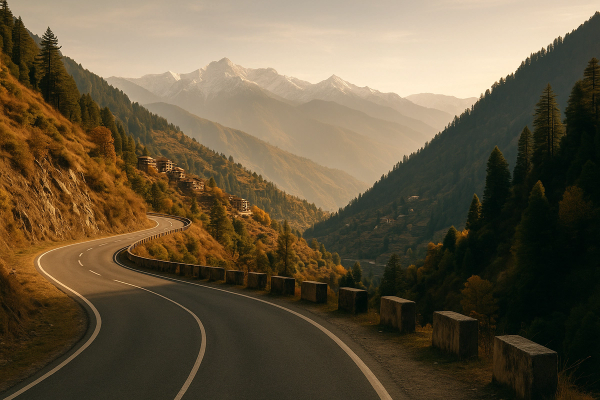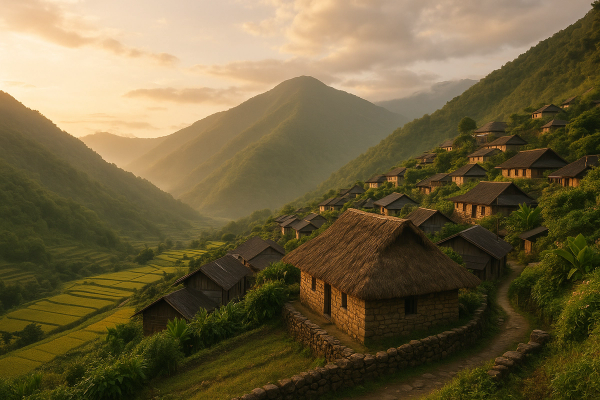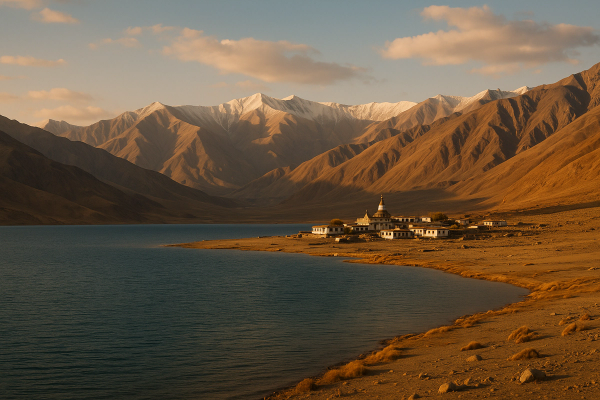More Than a Meal: Your Ultimate Guide to the Majestic Kashmiri Wazwan Feast#
Imagine this: You're seated comfortably, perhaps cross-legged on plush Kashmiri carpets. Before you lies a large copper platter, the Trami, piled high with fragrant rice. Then, dish after glorious dish arrives, each a testament to centuries of culinary tradition. This, my friend, is the beginning of a journey into the heart of Kashmiri culture – the legendary Kashmiri Wazwan. It's not just food; it's an experience, a celebration, an art form. If you're a food traveler, exploring cultural traditions, or planning a trip to India, understanding this traditional feast is essential.¶
For years, I'd heard whispers of this elaborate multi-course meal, a cornerstone of Kashmiri hospitality. When I finally experienced it in Srinagar, it exceeded every expectation. This Kashmiri Wazwan food guide aims to demystify this incredible culinary spectacle, from explaining the courses and highlighting key dishes like Rogan Josh and Gushtaba, to guiding you on where to experience authentic Wazwan in Srinagar. Prepare your senses; we're diving deep into a world of rich flavors, intoxicating aromas, and profound cultural significance.¶
What Exactly is Kashmiri Wazwan?#
At its core, Wazwan is a multi-course meal in Kashmiri cuisine, typically featuring an abundance of meat dishes (lamb, chicken, sometimes fish). The term 'Wazwan' breaks down into 'Waz' (meaning cook or chef, derived from the Sanskrit 'Waja') and 'Wan' (meaning shop or kitchen). It's prepared by master chefs known as Wazas, who are descendants of culinary artisans whose skills have been passed down through generations.¶
This isn't your everyday dinner. Wazwan is traditionally served during significant celebrations, especially Kashmiri Muslim weddings. It's a symbol of community, hospitality, and prosperity. Preparing a full Wazwan is a monumental task, often involving cooking overnight in large copper vessels over wood fires. The number of courses can range from a modest selection to an extravagant spread of up to 36 dishes!¶
Experiencing Wazwan is more than just eating; it's participating in a living tradition, a sensory immersion into the heart of Kashmiri culture.
The Setting: Srinagar – The Soul of Kashmir and Wazwan#
While Wazwan is enjoyed across the Kashmir Valley, Srinagar, the summer capital of Jammu and Kashmir, is arguably the best place for visitors to experience it authentically. Nestled amidst the Himalayas, Srinagar is famed for its breathtaking Dal Lake, serene Mughal Gardens, and vibrant local culture. It's a city where ancient traditions blend with stunning natural beauty.¶
For India travelers and global visitors seeking cultural travel intertwined with exceptional food travel, Srinagar offers the perfect backdrop. The city's bustling markets, historic mosques, and, of course, its dedicated Wazwan restaurants and skilled Wazas make it the epicenter for this unique culinary adventure.¶
Decoding the Wazwan: A Culinary Symphony Course by Course#
Get ready – experiencing Wazwan is a marathon, not a sprint! The meal is traditionally served on a large copper platter called a Trami, shared by a group of four people. The arrival of the Tash-t-naari, ornate copper jugs and basins for ritual handwashing, signals the start of the feast.¶
A base layer of fluffy, perfectly cooked rice forms the foundation on the Trami. Then, the procession of dishes begins, guided by the Waza or servers. While the exact order and selection can vary, here’s a glimpse into the typical flow, explaining the courses of this traditional feast:¶
The Appetizers: Setting the Stage#
- *Seekh Kebabs:* Minced meat (usually lamb) blended with spices, skewered, and grilled or cooked over coals. Often among the first items placed on the rice.
- *Tabak Maaz:* Tender lamb ribs simmered in yogurt and spices until soft, then shallow-fried until crisp and golden brown. Absolutely addictive!
- *Methi Maaz: Minced lamb tripe flavoured with fenugreek (methi*) and other spices. A unique texture and taste.
The Main Event: A Parade of Meat Masterpieces#
This is where the heart of the Wazwan truly beats. Expect a dazzling array of lamb and chicken dishes, each with its distinct flavour profile and preparation method.¶
- *Rogan Josh:* Perhaps the most internationally recognized Kashmiri dish! This iconic curry features succulent pieces of lamb cooked in a rich, aromatic gravy coloured deep red by dried Kashmiri chilies (milder than they look) and *ratan jot* (alkanet root). The flavour is complex, layered with spices like cardamom, cloves, cinnamon, and fennel. A must-try in any Kashmiri Wazwan food guide.
- *Rista:* Soft, pounded meatballs (usually lamb) cooked in a vibrant red, paprika-spiced gravy. The texture of the meatballs is incredibly fine and melt-in-your-mouth.
- *Yakhni:* A contrasting, milder curry. Tender lamb pieces simmered in a fragrant, yogurt-based gravy flavoured subtly with cardamom, cloves, and fennel seeds. It offers a cooling counterpoint to the richer dishes.
- *Aab Gosht:* Lamb shanks or pieces cooked in a flavourful, milk-based gravy, often subtly spiced with cardamom and fennel. Known for its delicate flavour and tender meat.
- *Marchwangan Korma:* For those who like it hot! This is a fiery chicken or lamb korma made with a generous amount of spicy red chilies. It definitely packs a punch.
- *Dhaniya Korma (Daniwal Korma):* Lamb cooked in a yogurt-based gravy heavily flavoured with fresh coriander (cilantro). A fresh, herbaceous flavour profile.
The Grand Finale: Gushtaba – The Dish of Kings#
Gushtaba is traditionally the final meat course served, signalling the end of the main feast. Its arrival is often met with anticipation and reverence. These are large, velvety-smooth meatballs made from meticulously hand-pounded lamb mince, simmered in a creamy, yogurt-based gravy delicately flavoured with cardamom, mint, and other subtle spices.¶
The texture is unlike anything else – incredibly soft and smooth, almost ethereal. The flavour is mild yet deeply satisfying. Refusing Gushtaba can be considered impolite, as it signifies the culmination of the Wazwan experience. It truly lives up to its reputation as the 'dish of kings'.¶
Insider Tip: The key to perfect Gushtaba (and Rista) lies in the pounding of the meat. Skilled Wazas pound the lamb mince on a stone slab with a wooden mallet for hours, achieving that signature velvety texture.
Accompaniments and Beyond#
- *Rice:* The essential canvas for all the dishes. Always plentiful.
- *Chutneys: Often served alongside, common varieties include Walnut Chutney (Doon Chetin), Onion Chutney (Gande Chetin), and Mint Chutney (Pudina Chetin*). They add brightness and cut through the richness.
- *Vegetarian Dishes: While Wazwan is overwhelmingly meat-focused, some vegetarian options might appear, such as Dum Aloo (potatoes in a rich gravy), Nadur Yakhni (lotus stem in yogurt gravy), or Haak* (collard greens). However, a traditional Wazwan is not designed for vegetarians.
- *Phirni:* A common dessert, a simple, creamy rice pudding flavoured with cardamom and saffron, served chilled in earthenware bowls.
- *Kahwa: The meal often concludes with a cup of traditional Kashmiri green tea, Kahwa*. Infused with saffron, cardamom, and sometimes almonds, it aids digestion and provides a warm, fragrant finish.
Where to Experience Authentic Wazwan in Srinagar#
Finding a truly authentic Wazwan experience requires a bit of planning. While many restaurants offer 'Wazwan thalis', these are often scaled-down versions. For the real deal:¶
- Attend a Kashmiri Wedding: This is, without doubt, the most authentic way to experience Wazwan. If you have local friends or contacts, receiving an invitation is a golden opportunity. The scale, atmosphere, and quality are unparalleled.
- Reputable Wazwan Restaurants: Several well-known restaurants in Srinagar specialize in Wazwan. While potentially catering more to tourists, they offer a reliable and accessible introduction.
* *Ahdoos Hotel (Residency Road):* A Srinagar institution, serving Wazwan for decades. Consistent quality and a formal setting. Expect prices around ₹1500-₹2500+ per Trami (serving 4, prices vary).
* *Mughal Darbar (Residency Road):* Another popular choice, known for its extensive menu and Wazwan offerings. Similar price range to Ahdoos.
* *Shamyana Restaurant (Boulevard Road):* Offers good Kashmiri food including Wazwan elements, often with views near Dal Lake. - Specialty Caterers/Home Experiences: For a more intimate setting, look for local caterers or home chefs who specialize in preparing Wazwan for smaller groups. This might require local connections or booking through specialized tour operators focusing on cultural travel.
My Tip: Don't just order individual dishes like Rogan Josh. Ask for the full Trami experience, even if it's a slightly smaller selection than at a wedding. Specify you want the traditional shared platter setup.
Essential Srinagar Travel Info (Beyond the Feast)#
While your Kashmiri Wazwan quest might be central, Srinagar offers much more. Here’s a quick practical overview:¶
Best Time to Visit Srinagar#
The ideal times are generally Spring (April to June) and Autumn (September to October).¶
- *Spring:* Pleasant weather, blooming tulips (Asia's largest Tulip Garden is here!), lush greenery.
- *Autumn:* Crisp air, stunning fall foliage (especially the Chinar trees turning gold and red), comfortable temperatures.
- *Summer (July-August):* Can be warm, occasional monsoon showers.
- *Winter (November-February):* Cold, often with snow. Beautiful in its own way (snow-covered landscapes), but travel can be disrupted.
Getting There & Around#
- *By Air:* Sheikh ul-Alam International Airport (SXR) in Srinagar has good connectivity with major Indian cities like Delhi, Mumbai, Bangalore. Pre-paid taxis and app-based cabs are available.
- *By Road:* Road trips are possible (e.g., from Jammu), but can be long and challenging depending on conditions. Check current travel advisories.
- *Local Transport: Auto-rickshaws are common for shorter distances (agree on fare beforehand). Taxis can be hired for day trips. Shikaras* (traditional wooden boats) are essential for exploring Dal Lake.
Accommodation in Srinagar#
Srinagar offers a wide range of stays:¶
| Type | Vibe | Price Range (Approx. per night) | Best For |
|---|---|---|---|
| Houseboats (Dal Lake/Nigeen Lake) | Unique Kashmiri experience, varying luxury levels | ₹2000 - ₹15000+ | Romantic stays, unique cultural immersion |
| Hotels (Boulevard Road, Lal Chowk, Rajbagh) | Standard amenities, varying budgets | ₹1500 - ₹20000+ | Families, business travelers, comfort seekers |
| Guesthouses/Homestays | Local interaction, budget-friendly | ₹1000 - ₹5000+ | Budget travelers, authentic experiences |
Practical Tips for Your Wazwan Adventure#
To make the most of your Kashmiri Wazwan experience:¶
- Come Hungry: Seriously. It’s a lot of food. Pace yourself.
- Observe Etiquette: Wash hands with the Tash-t-naari. Eat with your right hand (if eating traditionally without cutlery). Share the Trami communally and respectfully.
- Embrace the Meat: As mentioned, Wazwan is heavily meat-centric (mostly lamb). Vegetarians will find limited options within the core Wazwan sequence.
- Don't Refuse Gushtaba: Accept at least a small portion when offered; it's culturally significant.
- Hydrate (with Kahwa!): Drink water, but save room for the traditional Kahwa at the end.
- Book Ahead: For popular restaurants, especially during peak tourist season, making a reservation for a Wazwan meal is advisable.
- Combine with Sightseeing: Make a day of it! Explore the Mughal Gardens (Shalimar Bagh, Nishat Bagh), visit the Shankaracharya Temple for panoramic views, or wander through the Old City before your evening feast.
Responsible Wazwan & Cultural Travel in Kashmir#
Experiencing Wazwan is a privilege. Approach it with respect:¶
- Cultural Sensitivity: Dress modestly, especially when visiting religious sites or traditional settings. Be mindful of local customs and traditions.
- Support Locals: Choose local restaurants, hire local guides, buy authentic handicrafts (like Pashmina or woodwork, but be wary of fakes).
- Minimize Waste: Wazwan portions can be huge. Try smaller amounts initially; you can always have more. Avoid wasting food.
- Engage Respectfully: Interact politely with your hosts, servers, and the Wazas if you get a chance to meet them. Show appreciation for their skill and hospitality.
- Stay Informed: Be aware of the local situation and follow any travel advisories issued by your home country or local authorities. Travel responsibly and thoughtfully.
Final Thoughts: Is Kashmiri Wazwan Worth the Hype?#
Absolutely, unequivocally, yes. Kashmiri Wazwan is far more than just a meal; it's a delicious, complex, and deeply satisfying journey into the heart of Kashmiri identity. From the meticulous preparation by the Wazas to the communal sharing of the Trami, every element tells a story. Understanding the nuances, explaining the courses, and savoring iconic dishes like Rogan Josh and the climactic Gushtaba offers an unparalleled food travel experience.¶
Whether you're a seasoned India traveler or embarking on your first journey into its diverse culinary landscape, seeking out an authentic Kashmiri Wazwan traditional feast in Srinagar should be high on your list. It's an edible art form, a gesture of immense hospitality, and a memory that will linger long after the last bite of Phirni and the final sip of Kahwa.¶
Have you experienced Kashmiri Wazwan? Share your favourite dishes or tips for fellow travelers in the comments below! Ready to plan your own culinary adventure to Kashmir? Check out more India travel guides here¶














